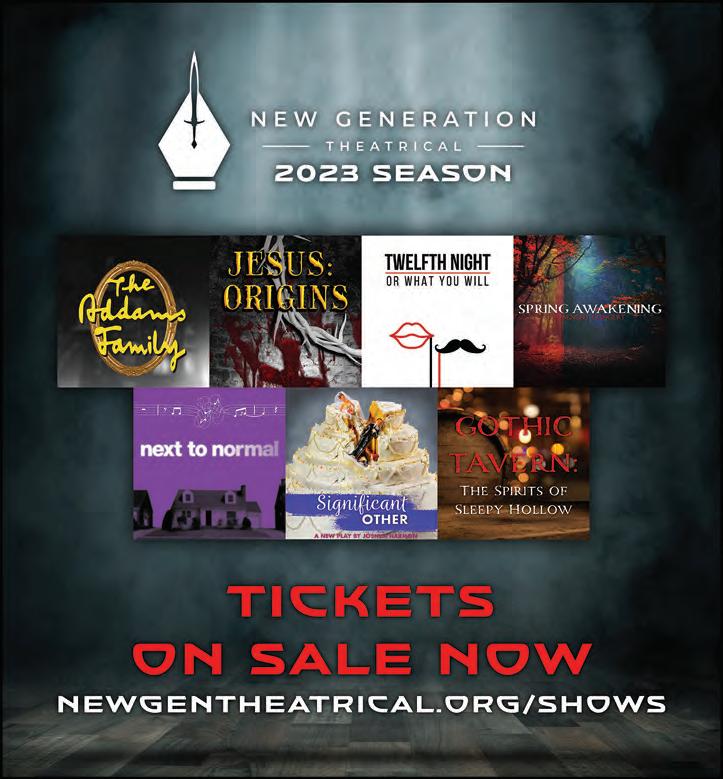
5 minute read
Live Active Cultures
BY SETH KUBERSKY
Central Florida’s two newest attractions both rely on atmosphere and interactivity, and both revive long-dormant venues. One is worth the journey, and the other … isn’t
After months of anticipation, last
week I finally got to experience Central Florida’s two newest attractions: Legoland Florida’s Pirate River Quest and Universal’s Great Movie Escape. Rather than high-speed thrill rides, both of these offerings rely on atmosphere and interactivity to immerse guests in nostalgic intellectual properties, and both were created by reviving long-dormant venues. But you may be surprised to learn which adventure I thought was worth the journey, and which one simply bites.
Pirate River Quest, the ambitious new ride at Winter Haven’s Legoland Resort, takes guests on a 20-minute tour of the historic Cypress Gardens canals, which have become infested by a rowdy crew of plastic pillagers. Passengers are tasked with recovering the stolen treasure of Captain Redbeard, who has been cursed by a tribe of mischievous monkeys and banished to the “sea of lost bricks,” by counting colored gems and giant coins that litter the riverbanks and participating in similar preschooler-friendly challenges.
The ride’s closest comparison in the Orlando area is the Magic Kingdom’s iconic Jungle Cruise, since both are slow-moving boat rides past minimally animated outdoor scenes, but there are a few major differences. First and foremost, Legoland’s boats are entirely free-floating and navigate a natural body of water, instead of being guided on a track along an artificial river. That means the Pirate River Quest captains leave the spieling to the prerecorded narration (which synchronizes with music and simple special effects as you sail by) and focus on not bumping into the canal walls, which still happens on occasion.
Morris, my skipper during the media preview, had been a tour boat lead at Cypress Gardens during the 1990s, and said, “I’m so glad that we’ve done this, I was afraid the canals were just going to go to pot.” Since taking over the property more than a decade ago, Legoland’s horticultural team have always done an admirable job of maintaining the vintage botanical displays, which were Central Florida’s first tourist attraction decades before Disney’s arrival. But the work they’ve now completed on the canals is truly remarkable, restoring the eroded waterways and integrating new life-sized creatures and characters — including an enormous octopus-like Kraken — without ruining the area’s natural integrity.
Another important element of Pirate River Cruise is that two of the fleet’s 10 vessels are fully ADA-accessible, allowing a standard wheelchair (or lighter electric one) to roll right aboard. There’s also no height restriction (although life vests are provided for guests age 6 and under) making it, as Legoland’s marketing head Kelly Hornick says, “a true family friendly ride that every single member of the family can ride.”
As a lifelong LEGO fan, I found Pirate River Quest’s scalawag scenery utterly charming, and even toy-hating adults who are suffering PTSD from stepping on painful plastic bricks will be soothed by the finale float along the open waters of Lake Eloise, where waterfowl and even river otters can be spotted along the marshy shoreline.
My only caveat, before you make the 80-odd-minute drive from Orlando, is that with only about a dozen passengers per boat, the attraction’s theoretical carrying capacity is under 250 guests per hour. That means you’d better either arrive at park opening and make Pirate River Quest your first destination, or prepare your booty for a long wait in the queue.
Over at Universal Orlando, the creative minds behind their theme parks and haunted houses have tried their hand at the popular escape room genre, gutting the CityWalk nightclub once known as the Groove and using the bones of its original Art Deco theater as the setting for a pair of attractions inspired by two of the studio’s biggest franchises. Universal’s Great Movie Escape features Back to the Future: Outatime on the first floor, and Jurassic World: Escape upstairs. Each separately ticketed experience accommodates up to eight guests at a time, and consists of eight highly themed rooms in which participants must solve various puzzles while advancing through the story.
The sequential multi-room format is just one way that Universal’s take deviates from the traditional escape room model. There’s no ticking clock or chance of failing, and every group will progress through the 50-minute game at approximately the same pace. That’s because there’s no punishment for failing any of the challenges, and solving puzzles quickly is only rewarded with repetitive additional tasks. There’s also no human interaction with your hosts once you enter the rooms; all backstory and instructions are pre-recorded, with the movies’ major characters referenced but never seen.
I tried out the Jurassic World escape game, which casts participants as trainee geneticists at the ill-fated park. I was extremely impressed with it as an immersive walk-through attraction, thanks to sets and props that authentically re-create the cinematic atmosphere, as well as spot-on sound and lighting effects which provided a handful of effective jump-scares. But as a veteran of dozens of escape rooms, I emerged frustrated with Universal’s failure to follow basic principles of good game design, such as providing clear feedback when a player makes progress, communicating consequences for mistakes, or offering hints that aren’t merely repetitions of the initial unclear instructions. I discovered afterward that my team (consisting of myself and a family of strangers I was randomly paired with) only scored an 11 out of 20, but there was never any indication along the way of where we were failing or succeeding.
Finally, Universal’s escape rooms are designed for operational efficiency, relying on touchscreens and video projections over tactile props that might require an employee to manually reset between groups. Unfortunately, this system robs players of experiencing any sense of exploration and discovery, which is ordinarily the genre’s greatest asset. I’m a big BTTF nerd, so I’ll return to experience the other story simply for its Christopher Lloyd voice-over and references to the extinct simulator. But at $50-$60 per person, I don’t feel the need to revisit Jurassic World unless they completely rethink many of the puzzles. If you find yourself escaping from Universal, feel free to ignore the frantic instructions; just try to enjoy it as an expensive, slow-paced haunted house.
Cypress Gardens’ canals get a second act with Pirate River Quest | photo by Seth Kubersky
skubersky@orlandoweekly.com orlandoweekly.com ● JAN. 18-24, 2023 ● ORLANDO WEEKLY 19













